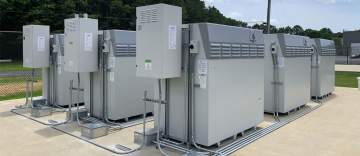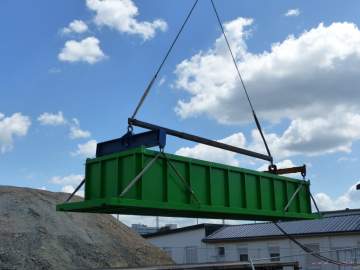 In this first part of EEWorld’s “virtual roundtable” discussion on flow batteries, our panelists delve into the impact that the emergence of flow batteries is having on energy storage compared with conventional rechargeable batteries: What performance advantage do flow batteries have? What is the barrier to large scale deployment? And how do the environmental or safety hazards of flow batteries compare with conventional rechargeable batteries? Joining us for this virtual roundtable are Olaf Conrad (OC), Managing Director with JenaBatteries, a maker of metal-free redox flow batteries. And Bruce Herzer (BH), Director of Marketing with Invinity Energy Systems, a maker of Vanadium flow batteries.
In this first part of EEWorld’s “virtual roundtable” discussion on flow batteries, our panelists delve into the impact that the emergence of flow batteries is having on energy storage compared with conventional rechargeable batteries: What performance advantage do flow batteries have? What is the barrier to large scale deployment? And how do the environmental or safety hazards of flow batteries compare with conventional rechargeable batteries? Joining us for this virtual roundtable are Olaf Conrad (OC), Managing Director with JenaBatteries, a maker of metal-free redox flow batteries. And Bruce Herzer (BH), Director of Marketing with Invinity Energy Systems, a maker of Vanadium flow batteries.
BH: Vanadium flow batteries (VFBs) substantially outperform the more widely used lithium-ion in a couple of areas. The first is throughput and utilization. VFBs can operate for 20+ years handling over 20,000 full charge-discharge cycles with no degradation. So they’re ideal for those high-use scenarios like frequency response where customers need to cycle the batteries more than once daily. They also provide future-proof flexibility to easily stack different sources of cost savings and revenue— from load shifting to wholesale trading to providing ancillary grid services. The second major advantage of VFBs is around fire safety. Where thermal runaway is a concern with lithium-ion, VFBs with their non-combustible liquid electrolyte doesn’t require additional fire suppression systems.
OC: Flow batteries allow for independent scaling of power and capacity. This makes flow batteries particularly advantageous over conventional batteries for long-duration applications of between four and ten hours of charging or discharging at nominal power. A second advantage is that flow batteries use a different raw material base and thus do not compete for limited metal resources such as cobalt, nickel, and lithium. JenaBatteries completely avoids any metal as storage material and can therefore predict its cost structure entirely independent from price fluctuations on the metal markets.
JS: What factors impact the ramp-up rate for flow batteries and what can be done to enable faster ramp-ups?

BH: Actually, we find the response time performance today is suitable for most grid applications. For example, we have one customer in the UK using vanadium flow to provide frequency response services to the National Grid. In this case, the flow system — including the batteries, control system, and power converters — is delivering the response to a signal in under 2 seconds, which is comparable to lithium. There’s a perception that because you need to pump electrolyte into the cell stack, VFBs have a slower response time, but when you compare how quickly either system can deliver power, they’re very similar.
OC: The chemistry of flow batteries is extremely rapid and does not limit the ramp-up. Adaptive and predictive management of operating parameters allows for ramp rates that are only limited by the time constants of the power electronics. So, the most important technical improvements for faster ramp-ups should be focused on power electronics.
JS: What environmental or safety hazards are associated with various flow battery technologies and how do they compare with rechargeable batteries?

OC: Flow batteries use at least one liquid as electrolyte. Consequently, the accidental release of liquid into the environment is the most severe environmental hazard. Given the huge volumes of liquid, which will be in the 100’s and 1000’s of cubic meters for MWh-class installations, a hypothetical discharge of the entire storage tank would be catastrophic, regardless of the storage material. Therefore, a battery installation has to be designed to prevent the release of liquids into the environment. Luckily, the chemicals and oil industries have decades of experience in the design and safe operation of storage tanks, as well as transport and transfer of even the most dangerous liquid goods. It is imperative that the flow battery industry utilizes tried-and-tested best practices as a starting point for their own safety engineering. As a result, safe storage tanks will include safety features such as double-walled design, permanent monitoring with leak sensors, secondary catch pans, etc.

By contrast, traditional batteries have no or little risk of leakage. However, those batteries are prone to thermal runaway scenarios that frequently lead to uncontrollable fires, the build-up of explosive gas mixtures, and explosions. Reports are becoming more frequent about out-of-control battery fires and subsequent spills of metal-contaminated, toxic run-offs of water from the firefighting efforts. For example, the recommended firefighting method for a burning electric vehicle is to provisionally extinguish the fire, lift the smoldering vehicle into a water-filled container to prevent re-ignition for a cool-down period of several days, and subsequent treatment of the cooling bath as toxic, hazardous waste.
BH: One of the benefits of vanadium chemistry is its relatively low toxicity. The electrolyte formulation eliminates the risk of secondary compounds like chlorine or bromine being released. The only gas released by a VFB is a small amount of hydrogen, which is easily dispersed with the fan system.
As mentioned, the most profound safety difference between vanadium flow and lithium batteries is the fire risk: there’s no risk of thermal runaway in a vanadium flow battery. We sometimes say that if anything, the liquid electrolyte would extinguish a fire.
Recyclability is also a factor of an environmental hazard. Lithium systems are not easily recyclable and carry specific end of life disposal costs that are not always recognized upfront. In contrast, the vanadium in our batteries never wears out and is fully recoverable and reusable. Most other components of the battery, like copper, are easy to recycle.

This Post Has 0 Comments